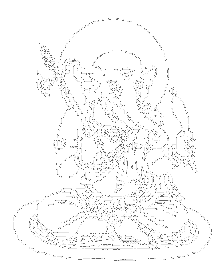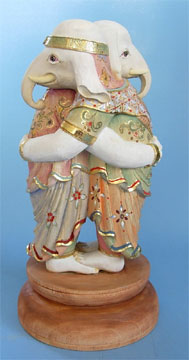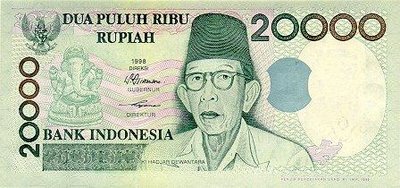Monday, September 04, 2006
Friday, August 11, 2006
108 Names of Ganesha
| OM GANESHWARAI NAMAH OM GANKRIDYA NAMAH OM GANNATHAYA NAMAH OM GANADHIPAYA NAMAH OM EKDRISHTAYA NAMAH OM VAKRATUNDAYA NAMAH OM GAJVAKRAYA NAMAH OM MAHODARAYA NAMAH OM LAMODARAYA NAMAH OM DHUMRAVARANAYA NAMAH OM VIKTAYA NAMAH OM VIGHNANAYAKAYA NAMAH OM SUMUKHAYA NAMAH OM DUMU NAMAH OM BUDDHAYA NAMAH OM VIGHNARAJAYA NAMAH OM GAJANAYA NAMAH OM BHIMAYA NAMAH OM PRAMODAYA NAMAH OM AANODAYA NAMAH OM SURAN NANDAYA NAMAH OM MOHATKATAYA NAMAH OM HAYRAMBHAYA NAMAH OM SHAMBARAYA NAMAH OM SHAMBHAVEY NAMAH OM LAMBAKARNAYA NAMAH OM MAHABALAYA NAMAH OM NANDANAYA NAMAH OM ALAMPATAYA NAMAH OM ABHIRVEY NAMAH OM MEGHNADAYA NAMAH OM GANGAJAYA NAMAH OM VINAYKAYA NAMAH OM VIRUPAKSHAYA NAMAH OM DHIRSHURAYA NAMAH OM VARPRADAYA NAMAH OM MAHA GANPATYE NAMAH OM BUDDHIPRIYAYA NAMAH OM SHIPRA PRASADNAYA NAMAH OM RUDRA PRIYAYA NAMAH OM GANADHYAKSHAYA NAMAH OM UMA PUTRAYA NAMAH OM AAGHNASHAYA NAMAH OM KUMAR GURVE NAMAH OM EESHAN PUTRAYA NAMAH OM MUSHAK VAHANAYA NAMAH OM SIDDHI PRIYAYA NAMAH OM SIDDHA VINAYAKAYA NAMAH OM SIDDHAYA NAMAH OM AVIGHAYA NAMAH OM TUMBARVE NAMAH OM SIMHAVANAYA NAMAH OM MOHINI PRIYAYA NAMAH OM KATAGKANTAYA NAMAH OM RAJ PUTRAYA NAMAH OM SHAALKAYA NAMAH OM SAMMITAYA NAMAH OM AMITAYA NAMAH OM KUSHMA MANDSAMSAMBHOOTHYE NAMAH OM DURJAYA NAMAH OM DHURJAYA NAMAH OM JAYAYA NAMAH OM BHOOPATYE NAMAH OM BHOOVANPATYE NAMAH OM AVYAYA NAMAH OM VISHWAKATRE NAMAH OM VISHWA MUKHAYA NAMAH OM VISHWA RUPAYA NAMAH OM NIDHYE NAMAH OM GHRUNYE NAMAH OM KRAYE NAMAH OM KAVINA MRUSHBHAYA NAMAH OM BHRAMANAYA NAMAH OM BHRAMANASPATYE NAMAH OM JYESHTA RAJAYA NAMAH OM NIDDHI PRIYA PATI PRIYAYA NAMAH OM SURYA MANDAL MADHYA GAYAY NAMAH OM KARAHATIDHAVSTA SINDHU SALILAYA NAMAH OM PUSHDANTABHIDE NAMAH OM UMANGKELIKUTUKINE NAMAH OM MUKTIDAYA NAMAH OM KUKPALNAYA NAMAH OM KIRITINE NAMAH OM KUNDALINE NAMAH OM HARINE NAMAH OM VANMALINE NAMAH OM MANOMAYAY NAMAH OM VYUUKHYAHATYDTYATSHRIYE NAMAH OM PADAHATIJITSHITYE NAMAH OM SADHYOJAATSVARNAMUJYAMEKILINE NAMAH OM DUDIRMITHRITE NAMAH OM DUSWAPNAHRITE NAMAH OM PRASHANAYA NAMAH OM GUNINE NAMAH OM NAADPRATITHISTAYA NAMAH OM SURUPAYA NAMAH OM SARVANETRADHIVASAYA NAMAH OM VIVASANA SHRAVAYA NAMAH OM PITAMBARAYA NAMAH OM KHANDARDAYA NAMAH OM KHANDENDUKRUTSHEKHARYA NAMAH OM CHITRANGDASHYAMDASHNAYA NAMAH OM BHAALCHANDRAYA NAMAH OM CHATURBHURJAYA NAMAH OM YOGADHIPAYA NAMAH OM TARKSTAYA NAMAH OM PURSHAYA NAMAH OM GAJKARNAKAYA NAMAH |
Saturday, August 05, 2006
Lord of Categories
Lord of CategoriesGanapati or Genesha, the Lord of Categories: All that can be counted or comprehended is a category (gana). The principle of all the classifications through which the relations between different orders of things, between the macrocosm and the microcosm, can be understood is called the lord-of-categories (Ganapati). I bow to you, lord of categories. You alone are the visible form of the principle. You alone are the creator, you alone are the sustainer, you alone are the destroyer, you alone are unmistakably the Principle-of-All (Brahma), the true Self. Ganesha or Ganapati is an extremely popular God in India. He is called Vighneshvara or Vighnaharta, the Lord of and destroyer of obstacles. People mostly worship Him asking for siddhi, success in undertakings, and buddhi, intelligence. He is worshipped before any venture is started. He is also the God of education, knowledge and wisdom, literature, and the fine arts. Ganesha is also one of the five Gods the worship of whom was popularised by Adi Shankaracharya; the other four are Vishnu, Shiva, Devi and Surya. The worship of these five deities is called the pancAyatana pUjA. In some cases, a sixth God, Skanda is also worshipped. |
Friday, August 04, 2006
The Ganapati Upanisad
| Auspiciousness to those who hear ---- thus the Shanti. 1 Om Gam.(A) I bow to Ganapati. 2 You clearly are the tattva(B). You alone are the creator. You alone are the maintainer. You alone are the destroyer.(C) Of all this you certainly are Brahman.(D) You plainly are the essence. 3. Always I speak amrta(E). The truth I speak. 4. Protect me. Protect the speakers. Protect the hearers. Protect the givers. Protect the holders. Protect the disciple that repeats. Protect that in the east. Protect that in the south. Protect that in the west. Protect that in the north. Protect that above. Protect that below. Everywhere protect! Protect me everywhere! 5. You are speech. You are consciousness. You are bliss. You are Brahma. You are being-consciousness-bliss. You are the non-dual. You are plainly Brahma. You are knowledge. You are intelligence. 6. You create all this world. You maintain all this world. All this world is seen in you. You are earth, water, air, fire, aether You are beyond the four measures of speech. You are beyond the three gunas. You are beyond the three bodies. You are beyond the three times. You are always situated in the muladhara(F). You are the being of the three Shaktis(G) . You are always meditated on by yogins. You are Brahma, you are Vishnu, you are Rudra, you are Agni, you are Vayu, you are the sun, you are the moon, you are Brahma, bhur-bhuvah-svar(H). 7 Ga is the first syllable, after that the first letter, beyond that m, then the half-moon all together. Joined with m, this is the mantra form. 8 The letter ga is the first form, letter a the middle form, m the last form. bindu the higher form, nada the joining together, samhita the junction. This is the vidya of Lord Ganesa. 9 Ganaka is the seer, nricad-gayatri the metre, Sri Mahaganapati the devata. Om ganapataye namah(I). 10 Let us think of the one-toothed, let us meditate on the crooked trunk, may that tusk direct us. 11. One tusk, four arms, carrying noose and goad, with his hands dispelling fear and granting boons, with a mouse as his banner. 12. Red, with a big belly, with ears like winnowing baskets, wearing red, with limbs smeared with red scent, truly worshipped with red flowers. 13. To the devoted a merciful deva, the maker of the world, the prime cause, who at the beginning of creation was greater than nature and man. 14. He who always meditates thus is a yogin above yogins. 15. Hail to the lord of vows, hail to Ganapati, hail to the first lord, hail unto you, to the big-bellied, one-tusked, obstacle-destroyer, the son of Siva, to the boon-giver, hail, hail! 16. He who studies this atharva(J) text moves towards BrahmË. He is always blissful. He is not bound by any obstacles. He is liberated from the five greater and the five lesser sins. Evening meditation destroys the unmeritorious actions of the night. At both evening and morning he is liberated from the bad and he attains dharma, artha, kama and moksa(K). 17. This atharva text should not be given to those not pupils. If from delusion a person so gives, he is a bad person. 18. He who wants something may accomplish it by 1,000 recitations of this. He who sprinkles Ganapati with this becomes eloquent. He who recites this on a fourth day becomes a knower of vidya. This is an artharva saying: ‘‘He who moves towards Brahmavidya is never afraid.’’ He who worships with fried grains becomes famous and becomes intelligent. He who worships with sweet-meat (modaka) gains the desired fruit. He who worships with samit and ghee by him all is attained, all is gained by him. He who makes eight brahmanas understand this becomes like the sun’s rays. In a solar eclipse, in a great river, or in front of an image having recited (this) he gets accomplished in the mantra. He becomes liberated from great obstacles. He is freed from great misfortunes. A) Om Gam -- The root or bija mantra of the deva. B) Tattva -- In this case the word tattva means all and everything. C) Creator, Maintainer & Destroyer -- These are the three gunas in their triple form. D) Brahman -- The Absolute. E) Amarta -- Literally, the imperishable. F) Muladhara -- The base cakra in the human body. G) Three Shaktis -- Of action, will and knowledge. H) bhur-bhuvah-svar -- The three worlds. I) Om ganapataye namah -- The extended mantra of the deva. J) Atharva -- The atharva is the fourth and heterodox veda. K) Dharma, Artha, Kama and Moksa -- The four aims of mankind: right thinking, acquistion of wealth, sexuality and liberation. |




